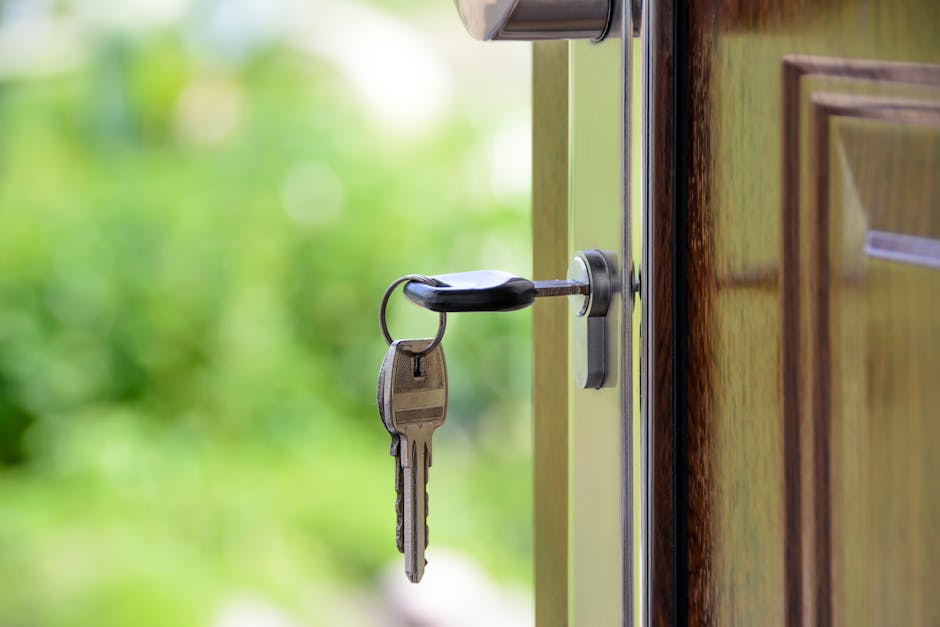Blog Content
Why Understanding Home Insurance Coverage Limits is Critical for Maine Homeowners
Home insurance coverage limits are the maximum dollar amounts your insurance company will pay for covered losses on your property. These limits directly determine how much financial protection you have when disaster strikes your Maine home.
Quick Answer: Home Insurance Coverage Limits Breakdown
- Dwelling Coverage (A): Covers your home's structure - should equal full replacement cost
- Other Structures (B): Typically 10% of dwelling coverage - covers detached garages, sheds
- Personal Property (C): Usually 50-70% of dwelling coverage - covers your belongings
- Loss of Use (D): Generally 20-30% of dwelling coverage - covers temporary living expenses
- Personal Liability (E): Common options: $100K, $300K, $500K - covers lawsuits against you
- Medical Payments (F): Typically $1K-$5K - covers guest injuries
If you're a Maine homeowner in Wells, Kennebunk, Ogunquit, or Biddeford, understanding these limits is especially important. Coastal properties face unique risks like nor'easters and flooding, while rising construction costs across Southern Maine mean yesterday's coverage limits may not rebuild your home today.
The stakes are high. Many Maine homeowners find too late that their $300,000 dwelling coverage won't cover their home's actual $400,000 replacement cost. Or that their grandmother's $2,500 jewelry collection is only covered up to the policy's $1,500 special limit.
This guide will walk you through exactly how to calculate the right coverage limits for your Maine property, avoid common pitfalls, and ensure you're properly protected without overpaying.
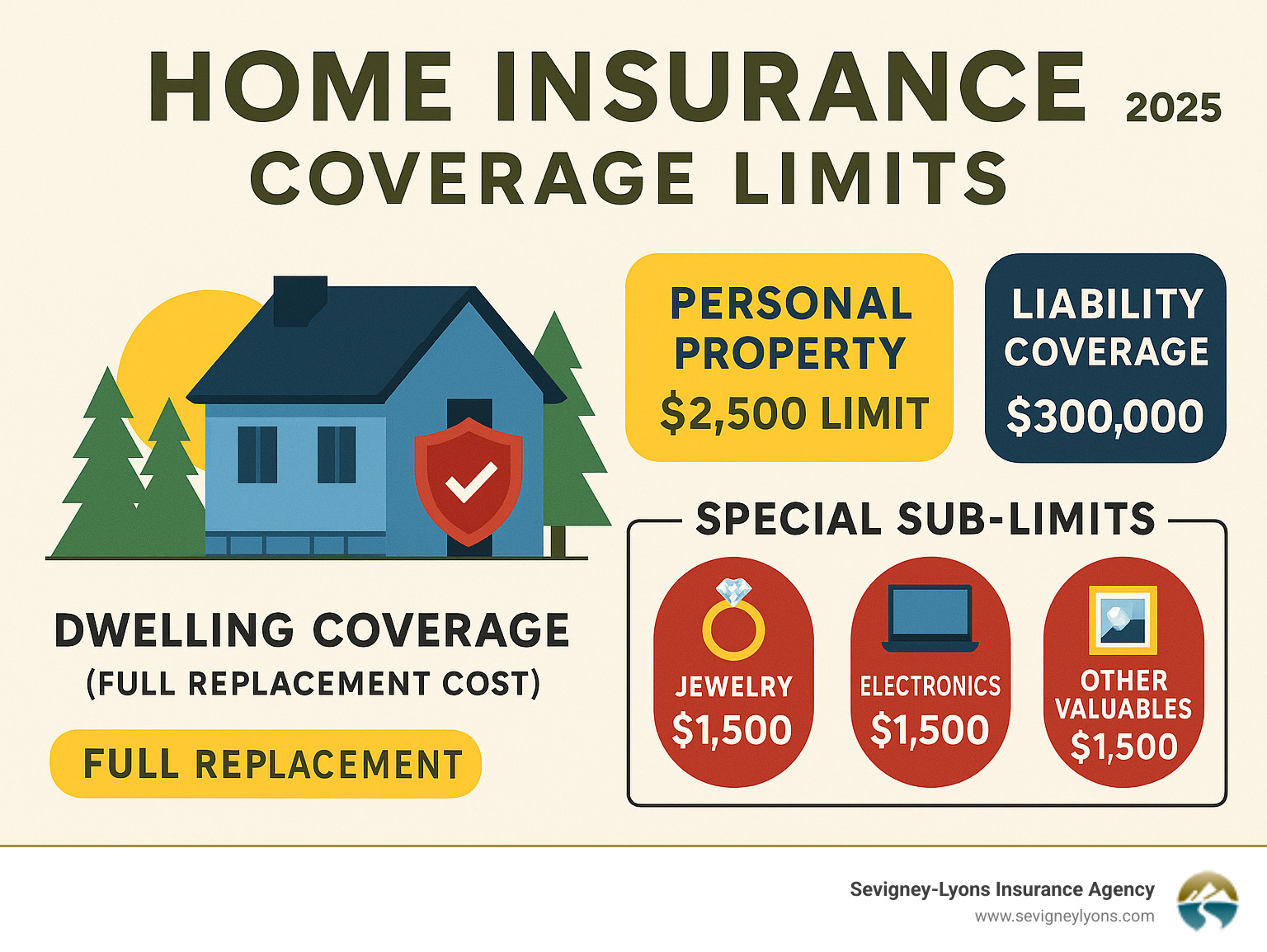
Quick Home insurance coverage limits terms:
What Are Home Insurance Coverage Limits?
Think of home insurance coverage limits as the financial ceiling on your protection. When disaster strikes your Maine home, these limits represent the maximum dollar amount your insurance company will pay for covered losses. Once you hit that ceiling, any additional costs come straight out of your pocket.
Your homeowners policy isn't just one big bucket of coverage - it's actually divided into six distinct sections, each with its own specific limit. Coverage A protects your home's structure itself, while Coverage B covers detached buildings like garages or sheds. Coverage C handles your personal belongings, Coverage D steps in when you can't live in your home during repairs, Coverage E provides personal liability protection, and Coverage F covers medical payments for injured guests.
Here's something that surprises many Maine homeowners: your coverage limit should reflect your home's replacement cost, not its market value. If your Wells home would sell for $500,000 but would only cost $400,000 to rebuild from the ground up, your dwelling coverage should be set at $400,000.
Home insurance coverage limits explained
When you file a claim, your insurance company pays up to your policy limit for that specific type of coverage. Let's say a kitchen fire damages your Kennebunk home and you have $300,000 in dwelling coverage. That's your maximum payout for rebuilding, period. If reconstruction actually costs $350,000, you're responsible for that extra $50,000.
This is exactly why understanding your home insurance coverage limits matters so much. Set them too low, and you could face a financial disaster on top of the physical one. Set them too high, and you're throwing money away on premiums for protection you don't need.
Coverage limits vs. special (sub-) limits
Here's where many homeowners get an unpleasant surprise: even within your overall coverage limits, there are often special sub-limits for certain categories of personal property. These smaller limits can leave you exposed even when you think you have plenty of coverage.
Picture this scenario: your policy provides $200,000 in personal property coverage, but it only covers jewelry up to $2,000, firearms up to $2,500, electronics up to $2,500, business property off-premises up to $500, and collectibles and antiques up to $1,500.
So if thieves steal your grandmother's jewelry collection worth $5,000, your policy only covers $2,000 - leaving you $3,000 short, even though you have $198,000 in unused personal property coverage.
The good news? You can often increase these special limits or add scheduled coverage for valuable items.
How do coverage limits work in a Maine homeowners policy?
Maine homeowners policies typically use percentage-based formulas to set your coverage limits automatically. Personal property coverage usually equals 50-70% of your dwelling coverage, while other structures coverage typically runs about 10%, and loss of use coverage generally falls between 20-30%.
If you have $300,000 in dwelling coverage, your policy might automatically include $150,000-$210,000 in personal property coverage, $30,000 for other structures, and $60,000-$90,000 for additional living expenses.
We regularly adjust these limits based on our clients' specific situations. Maine's coastal location adds another layer of complexity, with many policies including percentage-based deductibles for windstorm damage and state regulations influencing certain coverage requirements.
Calculating the Right Limits for Your Maine Property
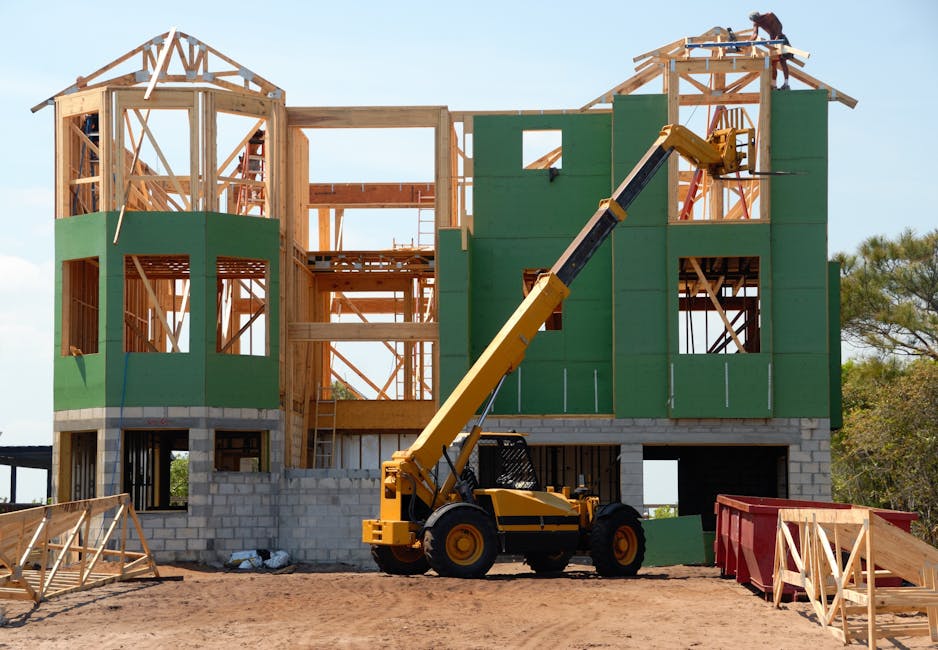
Getting your home insurance coverage limits right isn't just about picking numbers that sound good. It's about understanding what it would actually cost to rebuild your home today, replace your belongings, and protect your family's financial future.
The biggest mistake people make is underestimating costs. Construction materials have skyrocketed, labor is harder to find, and building codes have gotten stricter.
Dwelling Coverage Formula for Wells, Kennebunk, Ogunquit & Biddeford
Here's the reality of building costs in our area right now: you're looking at anywhere from $150 to $250 per square foot to rebuild a home, depending on the quality of materials and finishes.
For a typical 2,000 square foot home in Kennebunk, that breaks down to about $300,000 for basic construction, $400,000 for mid-range finishes, and $500,000 for high-end features. But coastal Maine homes rarely fall into the "basic" category.
Think about what makes your home special. Cedar shingles, custom millwork, lifted foundations for flood protection, or hurricane-resistant windows all add to your rebuilding costs.
Historic homes in Biddeford and Kennebunk present their own challenges. Try finding someone who can replicate 1800s craftsmanship or source period-appropriate materials. We always recommend getting a professional replacement cost estimate for older homes.
Personal Property: From Home Inventory to Coverage C Limit
Most people have no idea how much stuff they actually own. The average household has $35,000 to $50,000 worth of personal property, but Maine families often have much more when you consider outdoor gear, beach equipment, and well-stocked kitchens.
The 50-70% rule gives you a starting point, but we strongly recommend doing a room-by-room inventory. Walk through your house with your phone and take photos of everything.
Scientific research on home inventory best practices shows that homeowners who keep detailed inventories recover significantly more money from their claims.
Here's another important decision: replacement cost versus actual cash value coverage. Replacement cost costs about 10% more in premiums, but it's worth every penny. With actual cash value, your five-year-old laptop might only be covered for half its replacement cost.
Beating Special Sub-Limits on High-Value Items
If you have valuable items that exceed your policy's standard limits, you can schedule them separately with a personal property endorsement. We do this all the time for engagement rings, artwork, collectibles, musical instruments, and firearms collections.
Scheduling gives you serious advantages: coverage for the item's full appraised value, broader protection including accidental damage, no deductible, and worldwide coverage.
The cost is usually reasonable - often less than 1% of the item's value annually. For a $5,000 engagement ring, you might pay $40-50 per year for full coverage.
More info about Choose ME Homeowners Insurance Coverage can help you understand which belongings might benefit from this extra protection.
Loss of Use & Additional Living Expenses Limits
Loss of use coverage pays for your additional living expenses when your home becomes uninhabitable. The standard 20-30% of dwelling coverage might sound generous, but consider this: the average rebuild takes about seven months.
If you're staying in a hotel in Kennebunk during peak tourist season, eating all your meals out, and storing your belongings, costs add up frighteningly fast.
For Maine homeowners who rent out part of their property - especially those with seasonal rentals in Wells or Ogunquit - loss of use coverage can also include lost rental income.
Personal Liability & Umbrella Needs
Personal liability coverage protects you when someone gets hurt on your property or when you accidentally damage someone else's property. While policies often start at $100,000, we rarely recommend limits this low.
Consider bumping up your liability limits if you have a swimming pool, trampoline, frequent guests, significant assets to protect, teenage drivers, or dogs.
For Maine homeowners with assets exceeding $500,000, we often recommend umbrella insurance. Umbrella policies provide an additional $1 million or more in liability coverage and are surprisingly affordable - often just $200-400 annually.
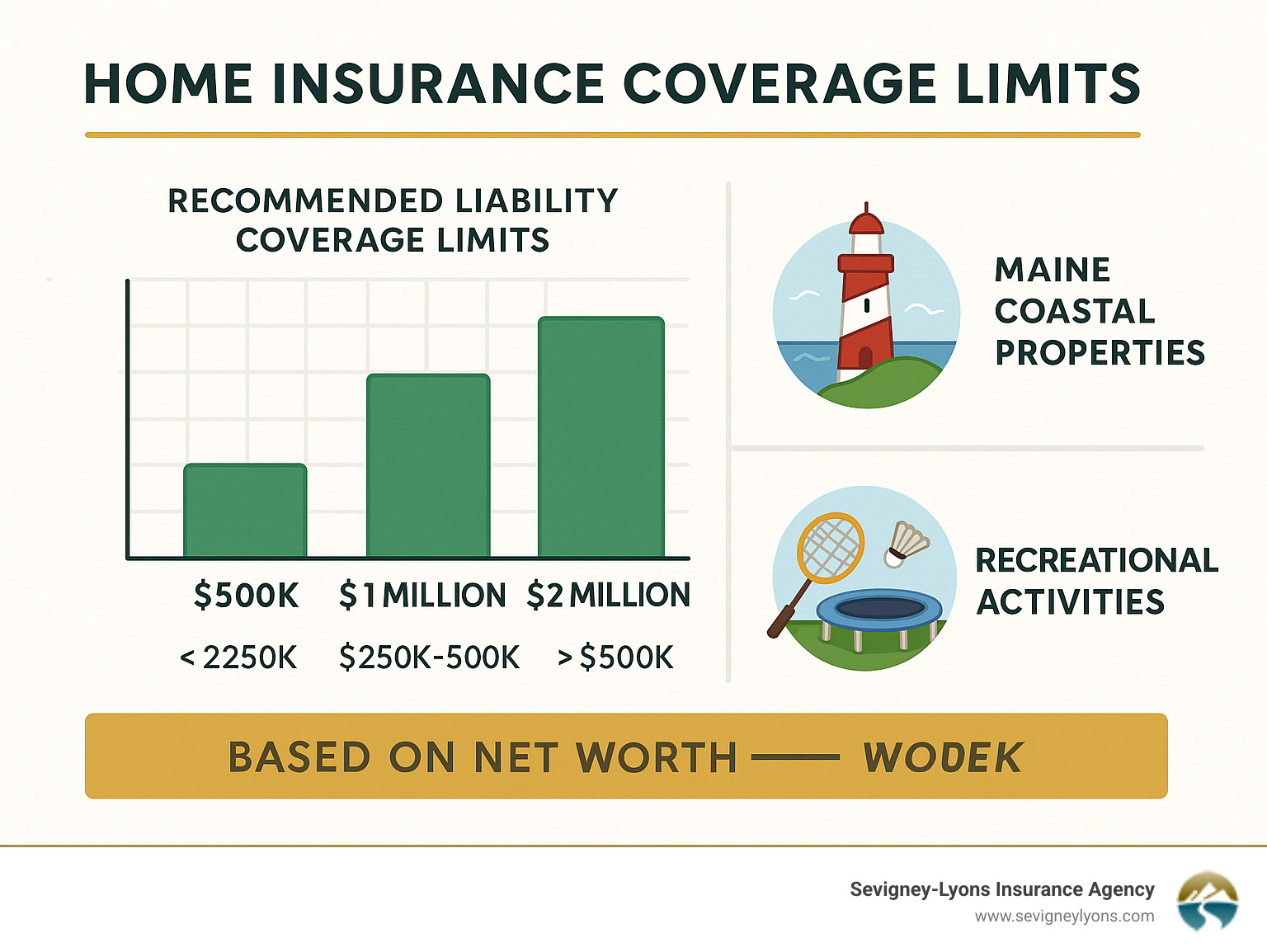
Navigating Deductibles, Exclusions & Endorsements
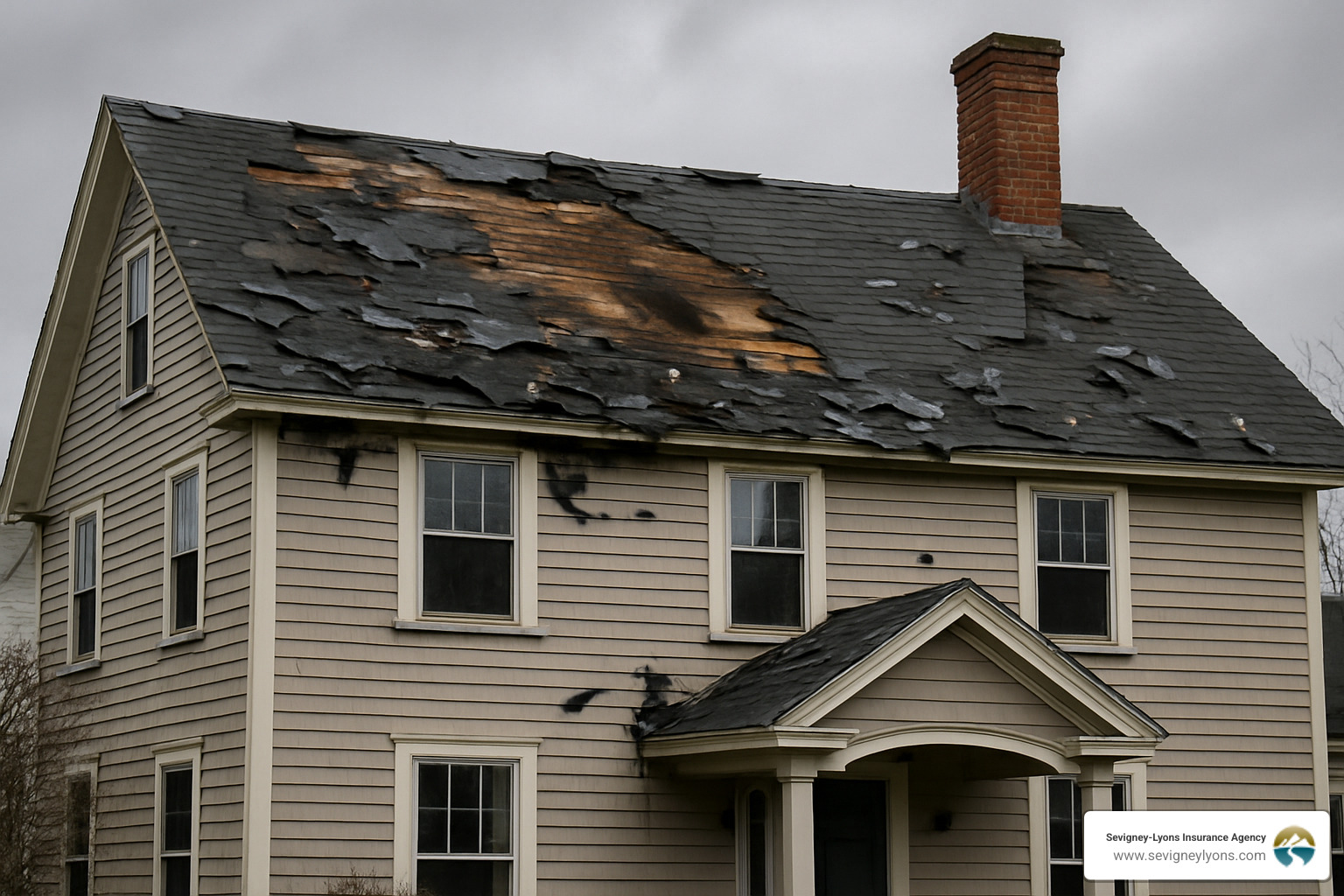
Your home insurance coverage limits are only part of the story. How deductibles, exclusions, and endorsements work together with those limits determines your actual financial protection when disaster strikes your Maine home.
Your coverage limit is the maximum your insurance will pay, but your deductible is what you pay first. The gap between what's covered and what's excluded can leave you exposed, while smart endorsements can extend your protection beyond standard limits.
How deductibles impact your coverage limits
Your deductible directly reduces your effective coverage. If you have a $500 flat deductible and file a $3,000 claim, you'll receive $2,500 from your insurance company.
But Maine coastal properties often have percentage-based windstorm deductibles that can create much larger out-of-pocket costs. If your Wells home has $400,000 in dwelling coverage and a 2% wind deductible, you'll pay the first $8,000 of any wind damage claim.
Real-world example: After a nor'easter damages your Ogunquit home's roof for $15,000, you'd pay $8,000 and your insurance would cover $7,000. That's much bigger than a standard $1,000 deductible.
Some coverages have no deductible at all, including personal liability claims, fire department service charges, and often additional living expenses when you're displaced from your home.
Endorsements that Raise or Protect Limits
Smart endorsements can dramatically improve your coverage without breaking the bank. We regularly recommend several game-changing add-ons for Maine homeowners.
Extended replacement cost coverage adds 25-50% above your dwelling limit when construction costs spike after major disasters. This proved invaluable during the pandemic when lumber prices doubled overnight.
Guaranteed replacement cost goes even further, paying whatever it takes to rebuild your home regardless of your policy limit.
Inflation guard automatically bumps up your dwelling coverage each year to keep pace with construction cost increases.
Ordinance or law coverage handles the extra costs to bring your home up to current building codes after a loss. This is especially crucial for older homes in historic Kennebunk or Biddeford neighborhoods.
Water backup coverage protects against sewer backup and sump pump overflow - common headaches in older Maine homes during heavy spring rains or snow melts.
Equipment breakdown coverage covers mechanical failure of your furnace, air conditioning, and smart home devices. With Maine's harsh winters putting extra strain on heating systems, this protection makes sense for most homeowners.
More info about Maine Hazard Home Insurance provides additional details on protecting your home against Maine's unique weather risks.
The key is understanding what's excluded from your base policy. Flood damage requires separate federal flood insurance. Earthquake damage needs a special endorsement. Replacement cost coverage for personal property costs about 10% more than actual cash value coverage, but pays full replacement cost instead of depreciated value.
Claims & Updates: Keeping Coverage Limits Current

Managing your home insurance coverage limits doesn't end when you buy your policy. Life happens, property values change, and your coverage needs evolve.
When disaster strikes your Wells or Kennebunk home, proper documentation becomes your best friend. Start taking photos immediately after the loss occurs - but only after ensuring everyone's safety. Document the damage thoroughly, save all receipts for temporary repairs and living expenses, and contact us as soon as possible to start the claims process.
What happens if a claim exceeds your limit?
When your claim exceeds your coverage limit, you become personally responsible for every dollar above that limit. It's that simple - and that scary.
Picture this: your beautiful Ogunquit home suffers $400,000 in fire damage, but you only carry $300,000 in dwelling coverage. You're now facing a $100,000 bill that your insurance won't cover. Even worse, if you're significantly underinsured, some policies include coinsurance penalties that can reduce your claim payment even further.
Real example: A Biddeford homeowner had $250,000 in dwelling coverage but faced $320,000 in rebuilding costs after a kitchen fire. Not only did they pay the $70,000 difference, but because they were underinsured by more than 20%, their policy's coinsurance clause reduced their claim payment by an additional $15,000.
The good news? This situation is completely preventable with proper coverage limits and regular reviews.
When and how to review your limits in Maine
Your home insurance coverage limits need attention more often than you might think. Maine's construction costs have been climbing steadily, and what seemed like adequate coverage two years ago might leave you exposed today.
Annual renewal time is your natural checkpoint. We review every client's coverage limits at renewal, looking at current construction costs, any home improvements, and changes in their personal property values.
After major renovations is another crucial review time. That beautiful kitchen remodel in your Kennebunk home didn't just increase your property value - it increased your replacement cost too.
Life changes also trigger coverage reviews. Getting married often means combining households and doubling personal property values. Having children brings new furniture, electronics, and toys.
Market shifts in construction costs require attention too. The pandemic taught us how quickly building material costs can spike. We've helped many clients add inflation guard endorsements that automatically adjust their coverage annually.
Don't wait for disaster to find you're underinsured. A quick conversation with us can identify coverage gaps before they become expensive problems.
Frequently Asked Questions about Home Insurance Coverage Limits in Maine
How often should I review and update my home insurance coverage limits?
We recommend reviewing your home insurance coverage limits annually at renewal time. Think of it like getting your car inspected - it's regular maintenance that protects your investment.
But don't wait for your renewal if certain events happen. Major home renovations or additions should trigger an immediate coverage review. That beautiful new kitchen in your Kennebunk home or the deck addition in Wells needs to be reflected in your dwelling coverage.
Life changes also matter more than you might think. Getting married often means combining two households worth of belongings. Having children means more toys, clothes, and equipment.
Significant purchases like jewelry, artwork, or collectibles should prompt a coverage review too. That anniversary ring or antique furniture you inherited might exceed your policy's special limits.
And here in Maine, we've seen construction costs fluctuate dramatically in recent years. Annual reviews help ensure you're not caught short when you need coverage most.
Can I raise special limits without increasing my whole policy?
Absolutely! This is one of the most cost-effective ways to improve your coverage.
You can increase special limits for specific categories without touching your overall personal property coverage. For example, if your policy covers $2,000 in jewelry but you have $5,000 worth, you can often increase just the jewelry limit.
Scheduling individual items is another smart approach. We regularly help clients schedule engagement rings, family heirlooms, or valuable collections. Scheduled items get their own coverage with no deductible and broader protection.
The cost is typically quite reasonable. Most special limit increases or scheduled items cost between $50-$200 annually, depending on the item's value and type.
Do Maine lenders require specific dwelling coverage limits for coastal homes?
Yes, but their requirements might not be enough to fully protect you. Most Maine lenders require dwelling coverage equal to at least your mortgage amount. So if you owe $300,000 on your Wells home, they'll require at least $300,000 in dwelling coverage.
But here's the problem: your mortgage balance might not reflect your home's actual replacement cost. If your home would cost $400,000 to rebuild but you only owe $300,000, you'd be underinsured by $100,000.
Coastal properties in Wells, Ogunquit, and Kennebunk often have additional requirements due to their exposure to wind and water damage. Some lenders require higher liability limits for coastal homes.
Flood insurance is a separate issue entirely. If your coastal home is in a flood zone and you have a federally-backed mortgage, you'll need flood insurance through the National Flood Insurance Program.
The key is understanding that lender requirements are minimums, not recommendations. They're protecting their investment - your mortgage balance. But you need to protect your entire investment - the full cost to rebuild your home and replace your belongings.
Conclusion
Getting your home insurance coverage limits right isn't just about checking boxes—it's about protecting everything you've worked hard to build. We've seen too many Maine families learn the hard way that inadequate coverage can turn a difficult situation into a financial disaster.
The math is simple, but the stakes are high. When your Wells home needs $400,000 to rebuild but you only have $300,000 in coverage, that $100,000 difference comes straight out of your pocket. When your grandmother's jewelry collection gets stolen but you only have the standard $2,000 coverage for a $5,000 loss, you're facing a painful shortfall.
Here's what we want every Maine homeowner to remember: Your coverage limits should reflect your actual replacement costs, not just what feels comfortable or what your lender requires. That means dwelling coverage based on full replacement cost, not market value. It means adjusting those standard percentage-based limits for personal property and other structures based on what you actually own and need.
Don't let special sub-limits catch you off guard. If you have valuable items—whether it's your engagement ring, your grandfather's gun collection, or your photography equipment—schedule them separately. The extra cost is minimal compared to the financial hit you'll take if you're underinsured.
Smart Maine homeowners also plan ahead. Extended replacement cost coverage protects you when construction costs spike after major storms. Inflation guard automatically increases your limits each year so you don't fall behind. These endorsements cost a little more upfront but can save you thousands down the road.
At Sevigney-Lyons Insurance Agency, we've been helping families in Wells, Kennebunk, Ogunquit, and Biddeford make these decisions for decades. We understand Maine's unique risks—from nor'easters to ice dams to coastal flooding. We know local construction costs and building codes. Most importantly, we know how to translate all that knowledge into coverage that actually protects you.
Your home is more than just your biggest investment—it's where your family builds memories and feels safe. Make sure your home insurance coverage limits are up to the job of protecting it. More info about Maine Home Insurance Quotes can help you get started, or give us a call to review your current coverage.
Don't wait until you're filing a claim to find your limits aren't enough. We're here to help you get it right from the start—because that's what neighbors do for each other here in Southern Maine.

